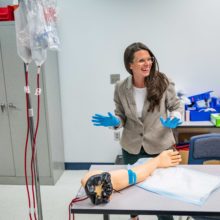

|
|
A study released this week highlights national transfer outcome data and examines how community colleges and four-year institutions provide opportunities for students to transfer and earn a bachelor’s degree. The study also includes a dashboard with state-by-state analysis of the data.
The two reports — one focused on community colleges and the other on four-year institutions — are a collaborative effort between the Community College Research Center at Teachers College at Columbia University, the Aspen Institute College Excellence Program, and the National Student Clearinghouse Research Center. According to a press release from the Aspen Institute, the reports are a call to action for both community colleges and four-year institutions to improve transfer pathways and student outcomes.
The data show that while nearly 80% of community college students aspire to earn a bachelor’s degree, only 16% of community college students (first time in college) transfer and complete a bachelor’s degree within six years of entering a community college. Overall, one third of community college students transfer to a four-year institution, and of those who successfully transfer, 48% earn a bachelor’s degree within six years of starting at community college.
While transfer rates and outcomes have been tracked for years, this analysis is the first to disaggregate the data by student subgroup. The research found that “low-income (11%), older (6%), Black (9%), and Hispanic (13%) students transfer and complete bachelor’s degrees at even lower rates than students overall.” Older students are defined as students ages 25 and up.
To view the report on community colleges, click here.
To view the report on four-year institutions, click here.
To view the state-by-state analysis dashboard, click here.
How to interact with the data and national trends
The dashboard includes state-by-state transfer and post-transfer outcomes and is disaggregated by student age, race/ethnicity, and neighborhood income.
The data examines various outcomes, including:
- Transfer-out rate: The rate at which first time in college (FTIC) students transfer to four-year institutions from a community college within six years. This has remained relatively flat over time across the U.S.
- Transfer-with-award rate: The rate of FTIC students who transfer to a four-year institution within six years after having first earned a certificate or associate degree from any institution.
- Transfer-out bachelor’s completion rate: The rate at which transfer students earn a bachelor’s degree within six years of their community college entry.
- Community college cohort bachelor’s completion rate: The rate at which FTIC students who start at a community college transfer to a four-year institution and earn a bachelor’s degree within six years of their community college entry.
- Transfer-in retention rate: The percentage of transfer students retained at the four-year institution they transferred to into the second year.
- Transfer-in bachelor’s completion rate: The percentage of transfer students who complete a bachelor’s degree at the institution they transferred to within four years after transferring in.
It’s important to note that the majority of the data looks at first time in college (FTIC) students, which excludes any students who are currently or have previously been dually enrolled in college while in high school. The state-by-state analysis includes a separate section examining transfer outcomes among students with prior dual enrollment (PDE transfer outcomes).
According to the reports, of the 1,636,1717 students who entered community college in fall 2015, 41% are first time in college (FTIC) students, 21% are current dual enrollment (CDE) students, 38% are prior dual enrollment (PDE) students.
While the transfer-out rate has remained relatively flat over time across the U.S., both the number of students who complete a credential prior to transferring and the rate at which transfer students complete a bachelor’s degree have both increased over time.
Key findings among subgroups
Notably, this study shows equity gaps among FTIC students by race/ethnicity, age group, neighborhood income, and gender. Transfer rates and bachelor’s degree completion rates are lower for low-income, older, Black, and Hispanic students.
Key findings among subgroups nationally:
- Transfer-out rates for older students (ages 25 and up) is 17% compared to 33% for all students. The report notes that adults seeking workforce credentials may not intend to transfer, which could explain lower transfer-out rates among this subgroup.
- Black (9%), low-income (11%), and older students (6%) transfer and complete a bachelor’s degree at much lower rates than students overall (16%).
- Only 36% of adults ages 25 and older, 34% of Black women, and 30% of Black men who transfer complete a bachelor’s degree compared to 48% of all students who transfer.
- Older students (47%) and Hispanic students (51%) had higher rates of transferring after having earned a credential than all students (44%). Specifically, 54% of Hispanic women who transferred completed a credential before transferring.
How does North Carolina compare
North Carolina’s community college transfer outcomes have steadily increased over time. In most categories, the state is on par with national averages when assessing all students.
The study highlights North Carolina as one of a few states that has shown improvements in transfer-out rates, which are FTIC students who transfer to a four-year institution within six years of their community college entry. North Carolina had the largest increase in transfer-out rates of any state, increasing from 24% to 31% from the fall 2007 to fall 2015 community college entry cohorts.
When looking at transfer outcomes by subgroup, many of the equity gaps seen in the national data exist in the North Carolina data as well. Low-income students in North Carolina are less likely to transfer than all students, and those who transfer are less likely to complete a bachelor’s degree than all students. However, the gap between all students and low-income students in transfer-out bachelor’s completion rate is smaller in North Carolina than nationally.
When looking at the data by race/ethnicity, Black students have worse transfer outcomes than all students in North Carolina. The gaps are largest in the transfer-with-award rate and transfer-out bachelor’s completion rate, as demonstrated in the graphs below. The rate of Black students who transfer having already earned a credential or degree is much lower in North Carolina (28%) than nationally (37%).
Dr. Audrey Jaeger, executive director of the Belk Center for Community College Leadership and Research, said the study shows the impact of the state’s commitment to strengthening transfer, specifically highlighting the policy changes North Carolina made to the Comprehensive Articulation Agreement (CAA) in 2014.
The CAA is a “statewide agreement governing the transfer of credits between NC Community Colleges and NC public universities.” The main goal of the CAA is to provide a smooth transfer process for students.
“This data represents a point in time when policy changes to the CAA were being fully implemented. North Carolina’s significant improvements in transfer outcomes and bachelor’s degree attainment could very well be connected to changes made to the CAA.”
Dr. Audrey Jaeger, executive director of the Belk Center for Community College Leadership and Research
In 2014, the North Carolina Board of Governors approved revisions to the CAA. The revised CAA included four key components meant to improve the transfer process from the North Carolina Community College System (NCCCS) to the University of North Carolina (UNC) System institutions. Research found that after CAA revisions, transfer students were between 5% and 13% more likely to complete a bachelor’s degree.
In addition to the CAA, an Independent Comprehensive Articulation Agreement (ICAA) exists between the NCCCS and the signatory institutions of North Carolina Independent Colleges and Universities (NCICU). Like the CAA, the ICAA is intended to provide a smooth transfer process for community college students who wish to continue their education at an institution within NCICU.
The role of dual enrollment
North Carolina has a long history of dual enrollment programs and has been recognized by Education Commission of the States as a model for dual enrollment programming and policy.
According to the study, transfer outcomes, including bachelor’s degree completion, among students with prior dual enrollment are stronger than those among students who did not enroll in college courses during high school.
Among students with prior dual enrollment, North Carolina outpaces the national average in the category of students who earn a certificate or associate degree prior to transferring to a four-year institution but falls behind in other transfer outcomes.
Similar to overall transfer outcomes, North Carolina has room for improvement with regards to closing equity gaps across racial and income groups among students with prior dual enrollment.
Recommendations
Both the recent study and a four-part transfer series authored by Dr. Jaeger detail several ways North Carolina can improve transform outcomes.
- Promote associate degree completion prior to transfer: According to the study, students who complete an award prior to transferring have higher bachelor’s completion rates than those with no prior award.
- Expand dual enrollment opportunities: While North Carolina has an impressive dual enrollment program (Career and College Promise), there remains continued room for improvement. In 2023, EdNC published an in-depth look at dual enrollment access, success, and recommendations for strengthening the program. You can find the recommendations here.
- Continue building clear transfer pathways between community colleges and four-year institutions to key industries. In the past year or more, community colleges along with private and public four-year institutions have expanded their partnerships by offering 2+2 programs. These types of programs include a clear transfer pathway in a key industry from a community college to a four-year institute. For example, an agreement between Bladen Community College and the University of Mount Olive allows Bladen students enrolled in agribusiness the option to transfer 60 credit hours toward one of four degree programs at the university. This agreement provides an opportunity for students to transfer to the university as a junior. This type of agreement is one of many across the state.
- Create an interactive data system that allows students to easily access academic records and see how credits would transfer at every UNC System institution. At the moment, no such data system exists. Jaeger suggests that a central statewide, open-access transfer platform would help students determine not only how their credits transfer but for which disciplines.
- Build on the foundation of the common course numbering system. The NCCCS has a common course numbering system and the UNC System identified comparable courses across their institutions. That means that equivalencies are now in place for more than 1,600 undergraduate, lower-level courses. Building upon this foundation could include extending the common course numbering system to all major requirements.
- Increase collaboration. Transfer work will require postsecondary, K-12, and business leaders to work together to increase transfer outcomes in an effort to fill jobs that require a bachelor’s degree.







